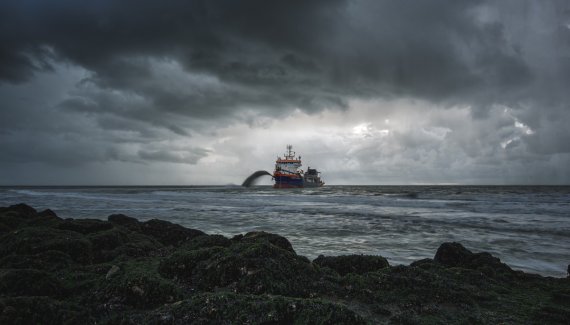Sand is being added to Ameland in an effort to satisfy the Wadden Sea’s hunger for the stuff. But where does that sand go? Professor Jakob Wallinga is using sand’s memory in order to find out.
The Wadden Sea is constantly eating away coastal sand. That natural erosion process is being intensified by rising sea levels. Unless action is taken, the mud flats will be submerged and the islands will shift towards the mainland. Sand replenishment — adding sand from elsewhere — is now being used to steer developments in the right direction. The replenishment is taking place in the navigation channel between Ameland and Terschelling. Five million cubic metres of sand was dumped in the sea off the coast of Terschelling in 2018.
No idea
Since then, the waves and currents have done their job and the sand has spread across the Wadden area. That is the theory, at least. But does this approach work in practice? ‘The effect of sand replenishment can be predicted for the confined North Sea coast of the western Netherlands but a coastal inlet like this is much more complex and dynamic,’ says Jakob Wallinga (Soil Geography and Landscape). ‘We actually have no idea what fraction of the sand enters the Wadden Sea.’
Surveying
Wallinga will be using luminescence in a new application to survey the routes taken by the additional sand. He will be exploiting the new sand grains’ natural luminescence signals. That signal, which Wallinga vividly refers to as the sand’s ‘memory’, developed in the sand’s place of origin deep in the North Sea as a result of natural radioactivity in the sea bed. The memory is released when the sand is exposed to light. Wallinga investigates this memory in his luminescence lab. He normally uses such signals to assess the age of layers of soil. The longer the sand has been in the ground, the stronger the memory signal. But that signal can also be used to distinguish between newly added sand and local sand. Local Wadden sand grains no longer have this memory as they have already been exposed to light.
The memory of the additional sand that has been extracted from the depths is essentially being used as a label. This method is new and will be developed further as part of TRAILS (the name of the Wadden Sea project). According to Wallinga, the main advantage is that the replenishment sand itself acts as a tracer, so there is no need to add an extra marker. Every new grain of sand that is added can be tested later.
Measurement campaign
An extensive measurement campaign is needed to find out where the replenishment sand goes. This will tie in with ongoing research by the Netherlands Institute for Sea Research (NIOZ) on the ecological impact of subsidence due to gas extraction. Wallinga is taking on a PhD researcher for the luminescence study. A NIOZ PhD candidate is investigating the consequences of sand replenishment for the Wadden fauna. A postdoc at Delft University of Technology will be modelling the transport of individual grains of sand.
A total of 1.3 million euros is available for the research. The funding is part of the Dutch Research Council’s ‘Living Labs in the Dutch Delta’ programme for research on large-scale nature-based interventions in coastal and river areas.
On luminescence
Sand’s memory is based on luminescence, the emission of light. Essentially, sand grains build up a signal under the influence of natural radiation sources in the ground. That signal can be measured — in the dark, because the signal is lost when exposed to light. The magnitude of the signal tells you how long the sand has been in that place.

 Foto: Shutterstock
Foto: Shutterstock